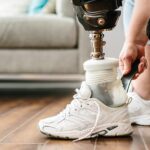Mentioning the month of April often brings to mind images of “fools,” showers, flowers, and re-birth after a long winter!
Amputation Prevention Awareness Month is not likely on your list of April associations, but it is and should be part of the discussion when it comes to the promise that accompanies Springtime.
Most people don’t realize there is a month dedicated to Amputation Prevention, not to mention that April holds such a designation. Why is this important and more relevant, than say “National Ice Cream Month” (July) or “National Pizza Month” (October)? First of all, every day is Ice Cream or Pizza Day, so why do we need a month to call further attention to them?
All kidding aside, Amputation Prevention Awareness is not something most of us consider for a variety of reasons. First, the thought of amputation is never pleasant. The situations surrounding the need for amputation are equally bleak, and the aftermath is often accompanied by a long and difficult road for the amputee and their support system of family and friends.
Why do we need awareness regarding amputation and its prevention? I can list facts regarding the 5-year mortality rates of non-traumatic amputees being worse than most forms of cancer. I can discuss the fact that someone undergoing an amputation of one leg has a greater than 50% chance of eventually requiring an amputation of their other leg. I can also cite the fact that less than 50% of below knee amputees ever become ambulatory again, and less than 25% of above knee amputees will ever walk again.
Instead, I would rather point out that approximately 50% of non-traumatic lower extremity amputations performed in the U.S. are done without any prior testing. Amputations are often based then on a surgeon’s opinion versus objective findings. How is this acceptable? Where is the public outcry? There is none because the public has no idea of the sad truths surrounding amputation. Sadly, the risk factors for amputation includes peripheral arterial disease and its associated factors, such as diabetes, aging and smoking. Ethnicity places certain populations at a higher risk for diabetes, especially Black, Hispanic and Native Americans.
What makes this all especially frustrating and sadder is that technology exists along with proactive measures such as screening and interventions that make amputation preventable in many instances.
Omeza’s technology can be one part of the solution in healing wounds that can lead to amputation. They also support “The Save a Leg, Save a Life Foundation” in their efforts to reduce unnecessary lower extremity amputation. Visit www.TheSALSAL.org to learn more.
April is certainly a time for renewed optimism. Increasing awareness surrounding amputation prevention awareness and converting that awareness into action, is imperative. This call to action has the potential to give so many facing a downward spiral and loss of dignity, among others, a chance to continue living a life that is fulfilling and whole.


